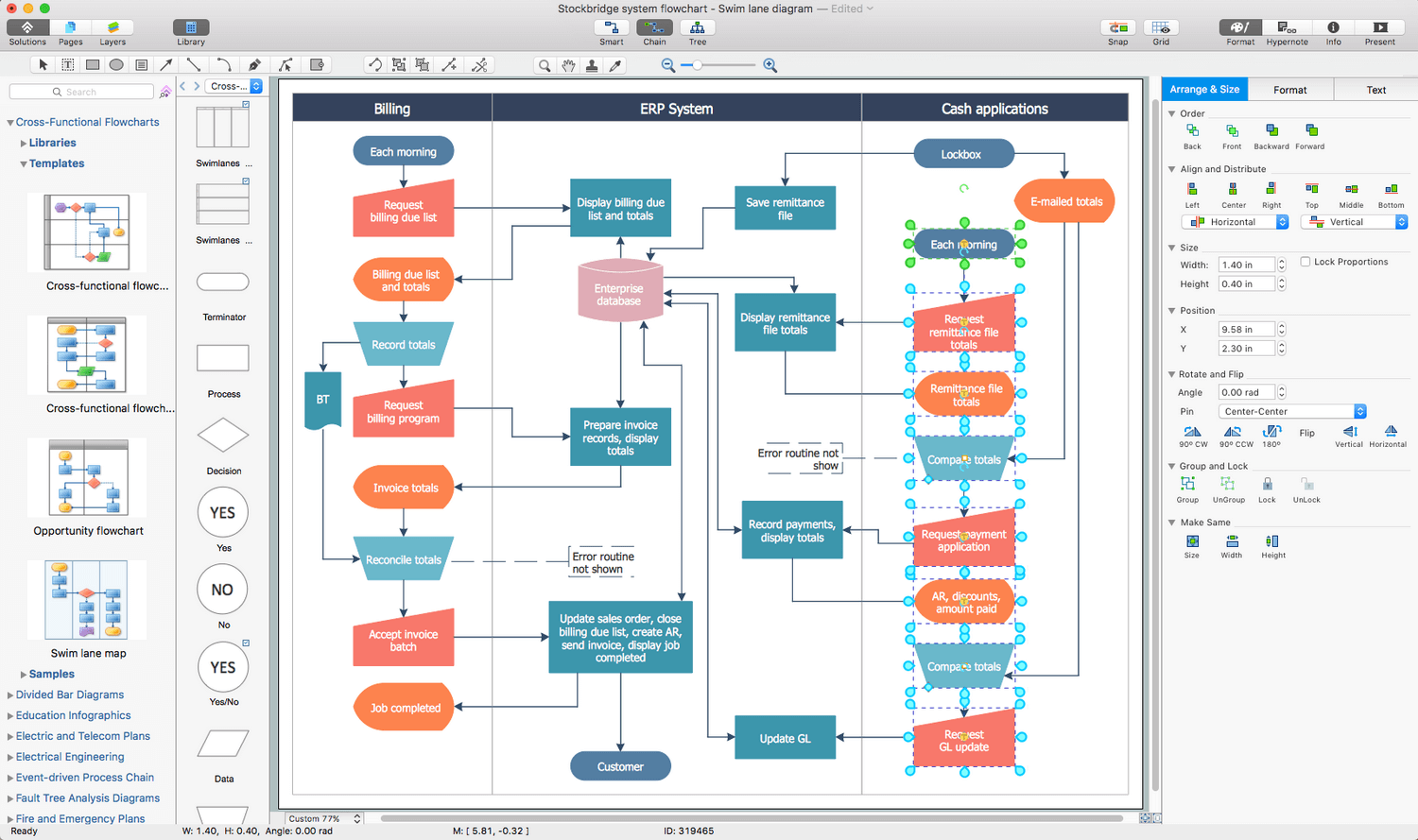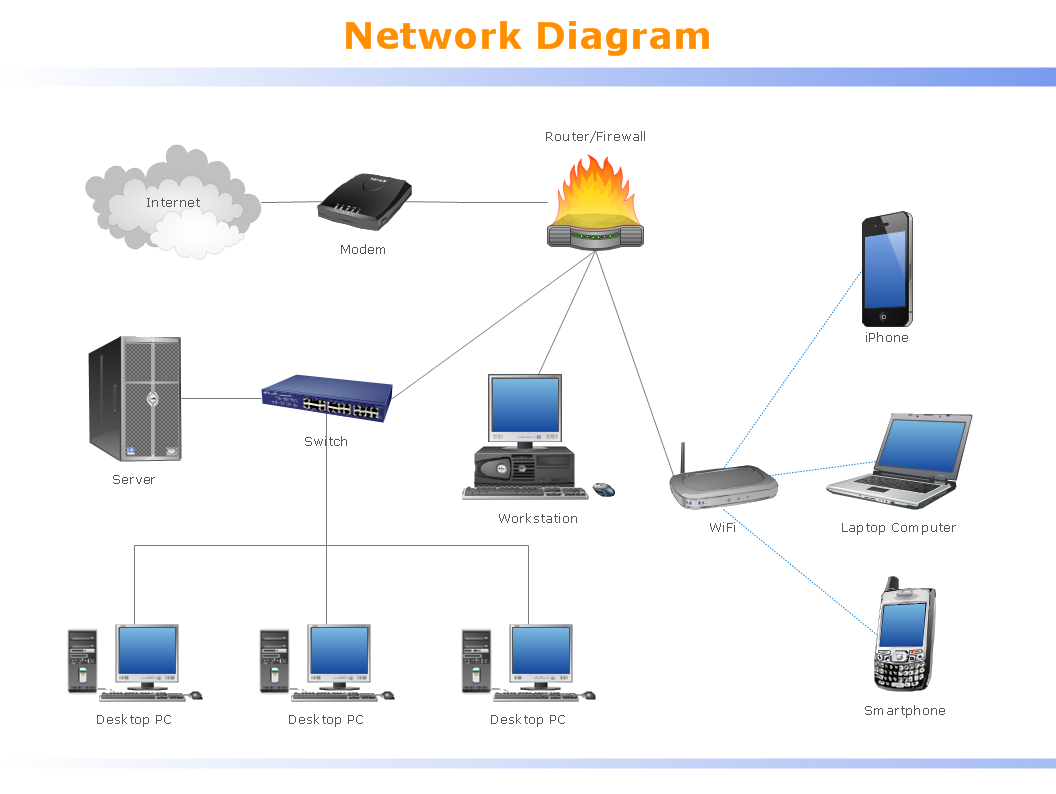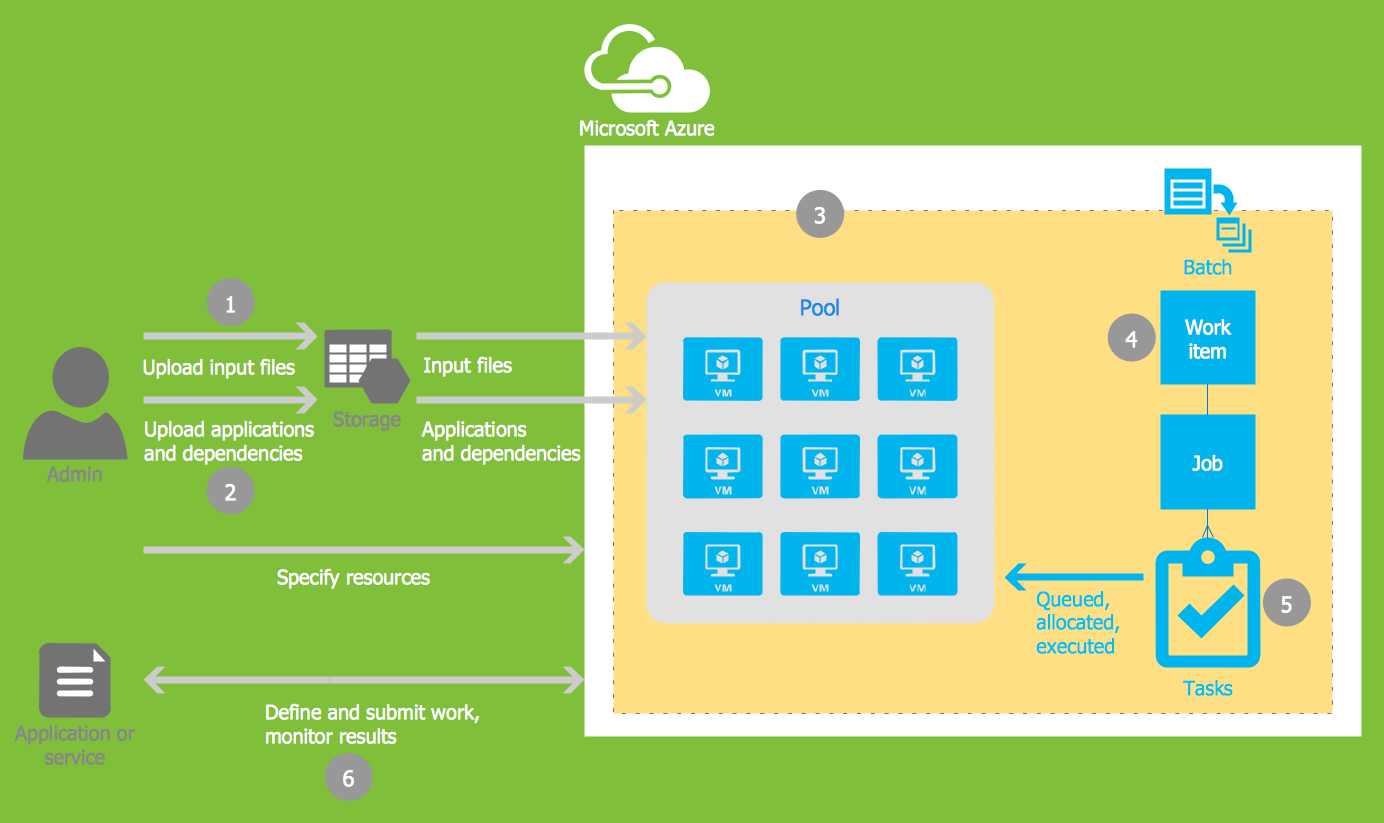Network Topologies
Small and medium-sized companies have network infrastructure which can total ten or more networking and computing devices (computers, servers, printers, telephones, routers, fax machines, scanners, etc.) All elements of a network have their own settings configured for fast and reliable service. As a company grows, it is necessary to incorporate new devices into the network, update existing devices, change the network topology, and even add new subnets. Changing the configuration of the network is only possible if there is documentation of the operating infrastructure.
To achieve high-quality documentation of network infrastructure, it is necessary to include the overall network structure topology, a communication scheme, the layout of the main devices, the scheme arrangement of servers in server racks, the list of installed services, services and databases for each server, and the scheme of corporate PBX.
Network Topology Diagram Software
ConceptDraw DIAGRAM is a powerful Network Topology Diagram software and intelligent vector graphics engine that can be used for network topologies diagrams. The shape libraries contain ready-to use icons of computers, servers, network devices, standard symbols and smart connectors for the quick and easy arrangement of network diagrams.

With ConceptDraw DIAGRAM you can simply create professional looking diagrams:
- Network topology,
- Physical network,
- Logical network,
- Network mapping,
- Home area networks (HAN),
- Wireless network,
- Cisco network topologies,
- Fully connected network topology,
- Bus network topology,
- Star network topology,
- Ring network topology,
- Mesh network topology,
- Tree network topology,
- Cable network,
- Network wiring,
- Local area network (LAN),
- Wide area network (WAN) topology,
- Metropolitan area networks (MAN),
- Campus area networks (CAN),
- Storage area networks (SAN),
- Near-me area networks (NAN),
- Personal area (PAN) networks,
- Near field communication (NFC),
- ISG network,
- Interactive voice response (IVR) networks,
- Activity network,
- Local network area,
- Network security,
- Network wiring cable,
- Computer network architecture,
- Enterprise private network,
- Internet networks,
- Network configuration,
- Active directory network,
- Network protocols,
- Network voip,
- Virtual networks,
- Virtual private networks (VPN),
- Rack diagrams,
- Network layout,
- Backbone network,
- Radio networks,
- Television networks,
- Telecommunication networks,
- Overlay networks,
- 3D network diagrams
- ATM-Network,
- Butterfly network,
- EIGRP,
- IGMP,
- MPLS,
- OSPF Network,
- P2MP network,
- DES network,
- Software Defined Networking System Overview,
- Cloud Computing,
- Mesh network,
- Internet Connectivity,
- Computer network,
- Digital Communications Network,
- Netflow architecture,
- Network Community Structure,
- phone networks,
- Overlay network,
- Office Network,
- VMware vNetwork Distributied Switch (vDS),
- EPN Frame-Relay and Dial-up Network,
What is Network Topology
Network topology is the topological structure of the computer network. Network topology can be physical or logical. The logical topology describes the network dataflows from one device to the next. The physical topology is the arrangement of the different elements of the computer network such as computers, cables and other devices. The physical topology shows the cabling layout of the network, the locations of the nodes and interconnections between cables and nodes. A network logical and physical topologies can be the same.
There are the following basic types of the network topologies:
Bus Network Topology
In local area networks where bus topology is used, each node is connected to a single cable. A signal from the source travels in both directions to all machines connected on the bus cable until it finds the intended recipient. If the data matches the machine address, the data is accepted, otherwise the machine ignores the data. Since the bus topology consists of only one wire, it is rather inexpensive to implement when compared to other topologies. However, the low cost of implementing the technology is offset by the high cost of managing the network. Additionally, since only one cable is utilized, it can be the single point of failure. If the network cable is terminated on both ends and when without termination data transfer stop and when cable breaks, the entire network will be down.
Pic. 1. Bus Network Topology
Star Network Topology
In local area networks with a star topology, each network host is connected to a central hub with a point-to-point connection. In Star topology every node (computer workstation or any other peripheral) is connected to central node called hub or switch. The switch is the server and the peripherals are the clients. The network does not necessarily have to resemble a star to be classified as a star network, but all of the nodes on the network must be connected to one central device. All traffic that traverses the network passes through the central hub. The hub acts as a signal repeater. The star topology is considered the easiest topology to design and implement. An advantage of the star topology is the simplicity of adding additional nodes. The primary disadvantage of the star topology is that the hub represents a single point of failure.
Pic. 2. Star Network Topology
Ring Network Topology
A network topology that is set up in a circular fashion in which data travels around the ring in one direction and each device on the ring acts as a repeater to keep the signal strong as it travels. Each device incorporates a receiver for the incoming signal and a transmitter to send the data on to the next device in the ring. The network is dependent on the ability of the signal to travel around the ring. When a device sends data, it must travel through each device on the ring until it reaches its destination. Every node is a critical link.
Pic. 3. Ring Network Topology
Mesh Network Topology
A mesh network is a network topology in which each node relays data for the network. All nodes cooperate in the distribution of data in the network. A mesh network can be designed using a flooding or a routing techniques. When using a routing technique, the message is propagated along a path, by hopping from node to node until the destination is reached. To ensure all its paths' availability, a routing network must allow for continuous connections and reconfiguration around broken or blocked paths, using self-healing algorithms. The self-healing capability enables a routing based network to operate when one node breaks down or a connection goes bad. As a result, the network is typically quite reliable. A mesh network whose nodes are all connected to each other is a fully connected network. Mesh networks can be also seen as one type of ad hoc network.
Pic. 4. Mesh Network Topology
Tree Network Topology
This particular type of network topology is based on a hierarchy of nodes. The highest level of any tree network consists of a single 'root' node that is connected with a single or multiple nodes in the level below by point-to-point links. These lower level nodes are also connected to a single or multiple nodes in the next level down. Tree networks are not constrained to any number of levels, but as tree networks are a variant of the bus network topology, they are prone to crippling network failures should a connection in a higher level of nodes fail/suffer damage. Each node in the network has a fixed number of nodes connected to it at the next lower level in the hierarchy, this number referred to as the 'branching factor' of the tree.
Pic. 5. Tree Network Topology
Fully Connected Network Topology
A fully connected network, complete topology, or full mesh topology is a network topology in which there is a direct link between all pairs of nodes. In a fully connected network with n nodes, there are n(n-1)/2 direct links. Networks designed with this topology are usually very expensive to set up, but provide a high degree of reliability due to the multiple paths for data that are provided by the large number of redundant links between nodes. This topology is mostly seen in military applications.
Pic. 6. Fully Connected Network Topology

Pic. 7. Common Network Topologies Diagram
These samples was created in ConceptDraw DIAGRAM diagramming and vector drawing software using the Computer Network Diagrams Solution from Computer and Networks area of ConceptDraw Solution Park. These diagrams show the basic types of the network topologies.
Pic. 8. Network Topologies Solution
Use the predesigned vector stencils, examples and templates from the Computer Network Diagrams Solution for ConceptDraw DIAGRAM to design your own professional Computer Network Topology Diagrams quick and easy.
















